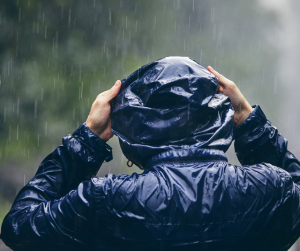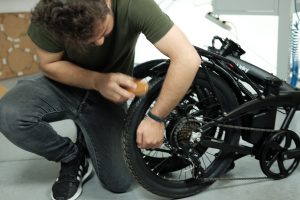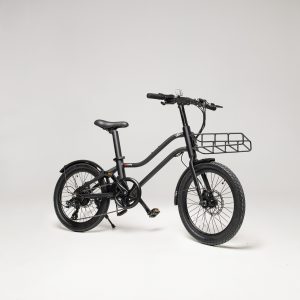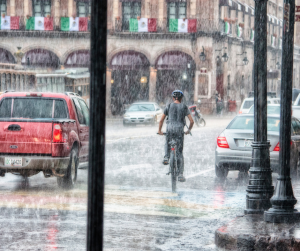Wondering if it is ok to ride or drive in the rain with your e-bike? The short answer is yes! Like everything, there are some do’s and don’ts that will help you to stay safer and trouble-free.
Rain isn’t going to stop you. This is especially true if you have taken the time to prepare your electric bike, yourself, and your gear for rainy rides before clouds appear. Do this and you should be able to avoid getting cold, wet, chaffed, or worst of all broken.
CAN ELECTRIC BIKES GET WET?
Most e-bikes are safe to ride in the rain, though there are some exceptions and important things to know about your specific e-bike before you and your bike go traipsing out in a late-summer monsoon. Most importantly, check with the manufacturer of your bike to see if it’s rated for riding in the rain. Still, there are a few additional considerations that may be useful for wet-weather riding.
All the Linky e-bikes have an IP rating of 65. This means that you are fully protected against dust and solid objects. And as far as the water tightness you are protected against jets of water, which is why you are fine to wash your bike with a hose. And you are also protected when riding through a shallow stream.
These wet-weather riding considerations include the type of equipment you’ve got on your bike — including fenders, weatherproof accessories and capable tires — to riding best practices, including braking early and slower cornering, among some other things.
1. USE BIKE FENDERS
Fenders help keep your clothing dry. While electric bikes are largely water-resistant – the drivetrain or motor can endure heavy splashes and the battery will not fail by getting it wet – you may want to consider adding fenders to your e-bike.
2. WEAR WEATHERPROOF CLOTHING
Scandinavians have a saying: “There’s no such thing as bad weather, only bad clothing (gear!).” With a few choice pieces of apparel, cycling in the rain can actually be very pleasant—especially as you pass all the other travelers stuck in traffic!
One of the most challenging components of riding in the rain is how quickly your clothing becomes wet. Because of this, it’s a good idea that you wear clothing that will keep you warm and as dry as possible.
Look for good quality water-resistant gloves that will keep your hands warm and dry. Popular materials include Gore-tex or in extreme cases neoprene.
You may even want to consider layering fleece, wool, polyester, or bamboo-based viscose fabrics so that you can vent or remove layers as conditions change.
Add rain pants or waterproof shoes to make the ride even more comfortable.

3. CLEAN YOUR EBIKE
Water, oil, and other substances from the road can leave a gross residue on your bike frame and components. Wipe your bike down periodically to prevent the residue from building up and affecting your ride.

Pay special attention to your chain! Your chain will get dirty quickly in the rain. Give it a little extra love by using a degreaser to remove excess grime and applying a few drops of lubricant. This can greatly extend your chain’s lifespan.
4. MAKE YOURSELF VISIBLE
I’m a proponent of always carrying at least a small light, even if I’m not planning on riding at night. This is more important so that you can be seen rather than see, especially if you’re riding near cars or other pedestrians. Rain can quickly hamper visibility, and even a small light can help ensure your presence doesn’t go unnoticed.
5. BRAKE EARLY
Just like driving a car on wet roads, your e-bike’s tires likely won’t hook up as well in the rain. Braking early and turning slower than normal are key to safe e-biking in the rain. Keep an eye out for known danger zones like metal sewer covers in the middle of the road, metal grates along the curbs, and painted stripes at intersections. These can all become very slippery in the rain and cause a crash before you can react.
6. ADJUST YOUR RIDING STYLE
Ride slow: don’t rush! Budget extra time to allow for the safest possible ride.
Reduce your tire pressure: this will slow you down a little but will provide a much better grip.
Layer up and plan ahead: because you know what’s worse than getting caught in an unexpected downpour? Spending the rest of your day in wet clothes because you didn’t bring a rain shell. This is perhaps most important for e-bike commuters, who I’d argue should find a way to keep at least a waterproof rain jacket in a pannier bag or their backpack at all times.
Check out Linky’s raincoat here.
7. DON’T SUBMERGE THE MOTOR AND BATTERY
Do not ride through water that will submerge your motor and battery.
Your battery in particular is susceptible to shorting out if submerged for any length of time. Something to be avoided :). Like any vehicle though, avoid riding through flooded water if you can, particularly fast-moving water.
We also recommend that you don’t leave your ebike outside in the weather for any length of time. This includes storing it in a dry place at home.
If your bike is really wet and you are concerned that water has gotten into the battery contact points then use a leaf blower to disperse the water after you take the battery out. Leave the battery out of the bike for a few hours to let the system completely dry.
It’s not always easy to get started when it’s already raining, but after the first few pedal revs, all the anxiety disappears! Be safe and ride on.
PURCHASE YOUR NEXT ELECTRIC BIKE WITH LINKY

E-bikes are quickly becoming one of the most sought-after and widely used means of transportation worldwide. If you’re considering purchasing an e-bike, but are still on the fence about it, contact Linky Innovation today. With years of experience, our staff can help answer any questions you might have about ebikes and make the process of purchasing one as seamless as possible.



